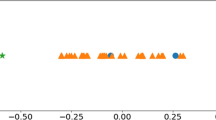Abstract
Based on the distribution of run feature and rank difference feature of coding sequence, this paper proposed a method to identify the type of common coding sequence. Using the concept of run distribution in combination with analysis of random nature within the coding sequence, it can be distinguished that if the encoding type belongs to block codes or others. Based on the structural features of turbo codes, rank difference analysis following the split of the coding sequence can distinguish the encoding type from convolutional and turbo codes. Herein we describe simulation experiment, the results of which demonstrate the validity and applicability of the proposed method.











Similar content being viewed by others
References
Zhang, Y., & Lou, C. (2010). Channel coding and recognition analysis. Beijing: Publishing House of Electronics Industry.
Gallager, R. G. (1963). Low density cheek codes. Cambridge, Mass.: MIT Press.
Li, Y. (2009). Study on encoding and decoding algorithm of LDPC code based on WiMAX (p. 06). Harbin: Harbin Institute of Technology.
Vladislav, S., Kschischang, F. R., & Pasupathy, S. (2000). Gallager codes for CDMA applications. IEEE Transactions on Communications, 48(11), 1818–1828.
Li, H. (2007). Encoding and implementation of LDPC codes in the DVB-S2. Changsha: Information and Communication Engineering Graduate School of National University of Defense Technology.
Wang, K. (2013). The design of high performance LDPC codes and its application for cognitive radio networks. Beijing: Beijing Jiaotong University.
Yang, X., & Gan, L. (2012). Blind estimation algorithm of the linear block codes parameters based on WHT. Journal of Electronics and Information Technology, 34(7), 1642–1646.
Zhang, C., Wanquan, P., & Bo, W. (2014). Construction of a new class of (2k,k,1) convolutional codes. Journal on Communications, 35(6), 200–206.
Qi, T. (2013). Research on convolutional code based on 3G. Wuhan: Central China Normal University.
He, X. (2013). Design and optimization of pseudo random interleaver in turbo code. Hangzhou: Hangzhou Dianzi University.
Xu, Z., Zhang, K., Lu, Q., & Leng, G. (2001). Matrix theory concise guide. Beijing: Science Press.
Bringer, J., & Chabanne, H. (2012). Code reverse engineering problem for identification codes. IEEE Transactions on Information Theory, 58(4), 2406–2412.
Moosavi, R., & Larson, E. G. (2011). A fast scheme for blind identification of channel codes. In Global telecommunications conference (pp. 1–5). Linkoping.
Park, S.-J., & Jeon, J.-H. (2009). Interleaver optimization of convolutional turbo coder for 802.16 systems. IEEE Communications Letters, 5(13), 339–341.
Shaker, S. W. (2014). DVB-RCS: Efficiently quantized turbo decoder. ICACT Transaction on Advanced Communications Technology, 2(3), 426–433.
Debessu, Y. G., Wu, H.-C., & Jiang, H. (2012). Novel blind encoder parameter estimation for turbo codes. IEEE Communications Letters, 12(16), 1917–1920.
Xie, H., Wang, F. H., & Huang, Z. T. (2013). A method for blind recognition of convolutional interleaver. Journal of Electronics and Information Technology, 35(8), 1952–1957.
Wang, X., & Xiao, G. (2006). Error correcting code—Principle and method. Xian: Xidian University Press.
Qi, L., Hao, S., & Li, J. (2011). Recognition method of RS codes based on Euclidean algorithm in galois field. Journal of Detection and Control, 33(2), 63–67.
Wen, N., Yang, X., & Bai, Y. (2011). A new recognition method of RS codes. Electronic Information Warfare Technology, 26(2), 36–40.
Zhou, P., & Gan, L. (2013). Blind recognition and parameter estimation of cyclic codes (p. 5). Chengdu: University of Electronic Science and Technology of China.
Liu, J., & Yang, X. (2013). Research on channel coding of convolutional codes. Hefei: Electronic Engineering Institute.
Chai, X., Cai, K., Lv, S., et al. (2010). Research on blind identification of convolutional codes. Journal of Circuits and Systems, 15(4), 38–44.
Wei, Y. (2013). Research on the decoding algorithms of channel codes in 3GPP UMTS and LTE systems. Shanghai: Shanghai Jiaotong University.
Wang, D., & Kobasyashi, H. (2009). Low-complexity MAP decoding for turbo codes. In Proceedings of IEEE vehicular technology (pp. 1035–1039).
Reng, D. (2013). High speed turbo decoding and cooperative spectrum sensing for next generation wireless communications. Xian: Xidian University.
Li, X. (2011). Key technologies of protocol identification for CCSDS data link layer. Beijing: Center for Space Science and Applied Research Chinese Academy of Sciences.
Acknowledgements
This work was supported by the National Natural Science Foundation of China (No. 61171170) and Natural Science Foundation of Anhui Province (No. 1408085QF115).
Author information
Authors and Affiliations
Corresponding author
Rights and permissions
About this article
Cite this article
Li, Xh., Zhang, M. & Yuan, Q. Research on Blind Identification Method of Error Correcting Code Type. Wireless Pers Commun 96, 6147–6160 (2017). https://doi.org/10.1007/s11277-017-4469-8
Published:
Issue Date:
DOI: https://doi.org/10.1007/s11277-017-4469-8




